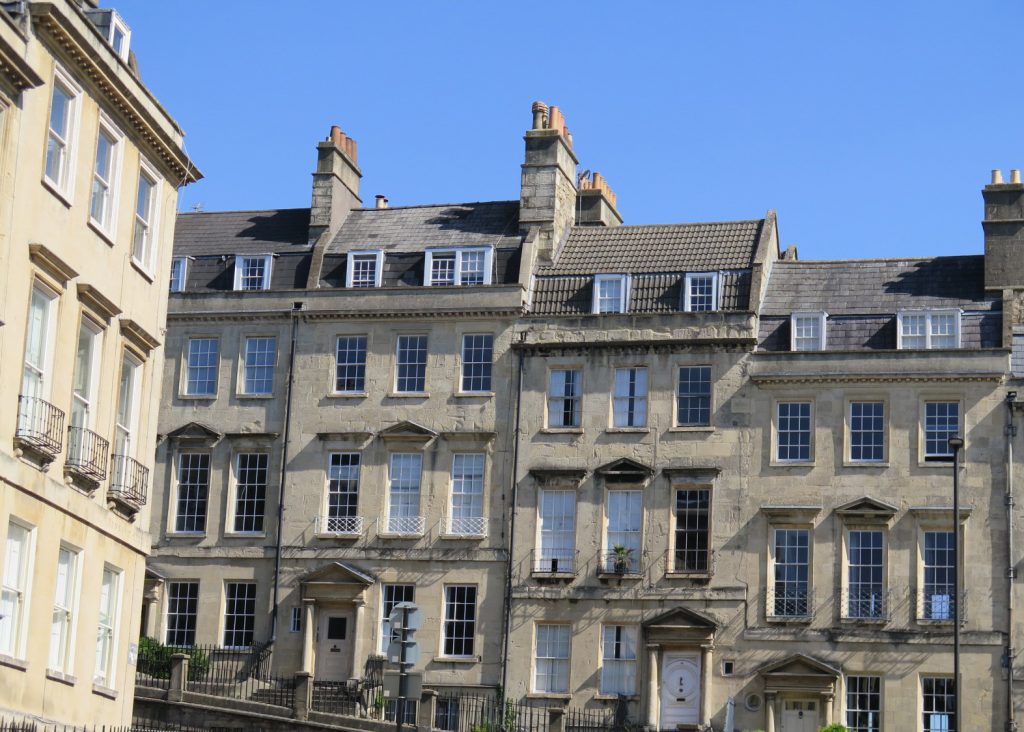Serving the City of Bath for more than 30 years, it’s no surprise that Avonvale Carpets has become a bit of an expert at fitting carpets and hard flooring in period properties. And there can be plenty of quirks for homeowners to contend with when considering new flooring options.
Although ‘period property’ actually means any that’s been built before the First World War, in Bath it’s homes constructed during the Georgian era (1714-1837) that dominate. Recognised for their symmetry and balanced proportions, Georgian properties were based on classical Grecian and Roman architecture.
That said, while the front facades of Bath’s famous terraces and crescents may well appear identical and symmetrical, what lies behind isn’t necessarily so. Take the Royal Crescent for example. When it was built, purchasers bought a length of uniform façade and then employed an architect to design a house to their own unique specification behind.
And being built more than 180 years ago, without formal building standards and without all the accuracy of modern metrology, Georgian properties will all have their different quirks, imperfections and idiosyncrasies. So while it goes without saying, no two homes will ever be the same…
Off-square
Rooms and walls for example are rarely perfectly square. ‘So what?’ you rightly say, ‘it’s all part of the charm and character of the property’. However, how a striped or patterned carpet looks when it meets that wonky wall is worth considering and consulting an expert on for the best approach and compromise to make.
And a property that’s built into a Georgian crescent is even more interesting when it comes to flooring. The room never was square. It’s narrower at the front and wider at the back, requiring very careful measurement and much thought when it comes to ‘setting off’ striped or patterned flooring.
Uneven floors
Plus of course, floors are never perfectly level and floorboards can be uneven. Original floorboards struck down by woodworm or dry rot might well have been replaced by new. Successive plumbing and electrical installations can mean there’s all kinds of holes, lumps and bumps to contend with. You might have the odd creaking floorboard too.
How much money, time and effort you wish then to spend on addressing an unlevel, wany floor does merit discussion. While a plywood or marine ply base layer and a good quality underlay can help greatly, you might need a whole new floor to achieve a perfectly level result. Suffice to say, if you first need the services of a carpenter or a builder, we’ll tell you.
Skirting boards as well
And since deep Georgian skirting boards should be running parallel to the floor, any unevenness that’s developed in the floor over time will of course be highlighted by the skirting board above. What’s more, the gap between skirting board and floor can be so variable that installing a gripper rod and a thick carpet can be a challenge.
Removing and reseating of skirting boards can certainly be done, but again this adds cost, time and effort. Again, a visual compromise might well be the path of least resistance and sensible economy, and one that’s more pragmatic, bearing in mind the foibles of a period property.
Original features
It can also be the case that you have a perfectly good period property floor, floorboards, parquet, flagstones, ceramic tiles etc. to which you want to apply a carpet or modern hard flooring. But you don’t want to damage it by nailing gripper rods or gluing underlay, you rightly want to protect it for future generations.
And this can be done as well. For example, a heavy weight rubber underlay bonded directly to a carpet can provide a highly stable flooring without the need for grippers, nails or gluing. Original feature floors can be safeguarded, it just needs some additional creative thinking.
In any case, listed building status might demand it.
And stairs
A staircase too can be a real statement feature of a period property and can look incomplete without the right carpet. There’s more than a few decisions to make here though.
Do you want plain, striped or patterned carpet? The answer might well be led by whether the staircase changes width, the size of landings and how often the direction changes. While say a striped carpet is best aligned with the top ‘nose’ of the stair, can the stripes be aligned as the staircase turns? Or is there a compromise to be had?
For a more contemporary look, you may want the carpet to meet the sides of your stairs. Or perhaps you prefer a traditional stair runner, a carpet running down the centre of the stairs which leaves the edges of the stairs exposed? And if it’s the latter, do you also want decorative stair rods or clips as well?
Plus of course, you might be lucky enough to have an original ceramic tiled floor in your hallway that you wish to keep. This means that the stair carpet will need to compliment it by picking out the dominant colours. What’s best? And should it be wool or nylon, or something else for heavy usage?
All such questions, and many more about fitting new flooring in a period property in Bath and Wiltshire, we can answer. We understand the beauty and nostalgia of a period property and we know how to handle its quirks and imperfections.
Yes, a certain amount of compromise can be needed, but there’s always a best solution, one that properly balances aesthetics, practicality and budget. Pop into our shop on Kingsmead Square in Bath and let’s discuss it.

